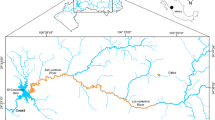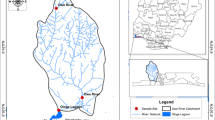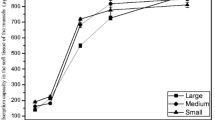Abstract
The bioaccumulation pattern of copper (Cu) in gill, liver, kidney, and muscle of different sizes (fingerlings and adult age) of healthy Mystus vittatus when exposed to their respective sublethal concentrations of Cu-water, containing one-third 96-hr LC50 level (6.20 and 15.95 mg L−1) for short-term (120 hr) and one-eighth 96-hr LC50 level (2.33 and 5.98 mg L−1) for long-term experimentation, respectively, has been analyzed. The Cu shows a maximum deposition (p < 0.01) in the liver (82.12 and 70.65 μg/g) followed by gill (74.35 and 63.69 μg/g) and kidney (61.52 and 54.09 μg/g) both in fingerlings and adult fish, respectively, during 28 days of exposure. The lowest deposition of Cu is found to be 0.83 and 0.93 μg/g in fingerlings and 0.79 and 0.86 μg/g in adult muscle tissue during short-term (120 hr) and long-term (28 days) exposure periods, respectively. Comparing the accumulation of Cu on the two size groups at both exposure levels, it is obvious that the fingerlings showed higher Cu concentration in all tissues than those of adult fish. Another equally important finding is that the depuration of Cu by maintaining the bioaccumulated fish (long-term exposed group) of both size groups in quality dechlorinated ground water reveals that there is a significant (p < 0.05) reduction in Cu concentration in different tissues as the day passes. A comparison of the performance of the two size groups in respect of depuration clearly indicates that the fingerlings have taken 24–43 days (gill-kidney), whereas in mature fish it is 21–39 days (gill-kidney) to reach the level of control fish. Among the various tissues in both size groups, gill took the minimum number of days for complete recovery, whereas the muscle tissue did not significantly eliminate Cu even after 30 days of depuration. These data constitute a reference for future studies on the evolution of Cu accumulation and elimination tendency in relation to different size groups of fish in the ecotoxicological testing scheme for hazard assessment.

Similar content being viewed by others
References
Anderson PD, Spear PA (1980) Cu pharmacokinetics in fish gills kinetics in pumpkin seed sunfish, Lapomis gibbosus of different body sizes. Water Res 14:1101–1105
Benoit DA (1975) Chronic effects of copper on survival, growth and reproduction of the blue gill Lepomis macrochirus. Trans Am Fish Soc 104:353–358
Bingham FT, Sposite G, Strong JE (1984) The effect of chloride on the availability of cadmium. J Environ Qual 13:71–74
Bradley RW, Morris JR (1986) Heavy metals in fish from a series of metal contaminated lakes near Sudbury, Ontario. Water Air Soil Poll 27:341–354
Calmari D, Gaggino GF, Paccmetti G (1982) Toxicokinetics of low levels of Cd, Cr, Ni and their mixture in long-term treatment on Salmo gairdneri. Chemosphere 11:59–70
Cossa D, Bourget E, Piuze J (1979) Sexual maturation as a source of variation in the relationship between cadmium concentration and the body weight of the Mytilus edulis. Mar Poll Bull 10:174–178
Couture P, Rajotte JW (2003) Morphometric and metabolic indicators of metal stress in wild yellow perch (Perca flavescens). Aquat Toxicol 64:107–120
Dallinger R (1995) Metabolism and toxicity of metals: metallothioneins and metal elimination. In: Gajaraville MP (ed) Cell biology in environmental toxicology. Universidade del Pais Vasco, Bilbao, pp 171–190
Devi M (1990) Effect of Cu, Zn and their combination on the accumulation and depuration and their impact on protein and growth in Oreochromis mossambicus. M.Phil. Dissertation, Madurai Kamaraj University, Madurai, India
FAO (1975) Manual of methods in aquatic environment research. Part 1, p 223
Finney DJ (1978) Statistical methods in biological assay, 3rd ed. Griffin Press, London, p 508
Glynn AW, Haux C, Hogstrand C (1992) Chronic toxicity and metabolism of Cd and Zn in juvenile minnows (Phoxinus phoxinus) exposed to a Cd + Zn mixture. Can J Fish Aquat Sci 49:2070–2079
Glynn AW, Olssoni PO (1991) Cadmium turnover in minnows, Phoxinus phoxinus pre-exposed to waterborne cadmium. Environ Toxicol Chem 10:383–394
Heath AG (1987) Water pollution and fish physiology. CRC Press, Florida, p 245
Hogstrand C, Haux C (1991) Mini-review: Binding and detoxification of heavy metals in lower vertebrates with reference to metallothionein. Comp Biochem Phys C 100:383–390
John L, Fernandez V (1998) Incidence of trace metals in Scylla serrata, an edible crab from Ashtamudi estuary, India. J Environ Biol 19:99–106
Joshi PK, Bose M, Harish D (2002) Haematological changes in the blood of Clarias batrachus exposed to mercuric chloride. J Ecotoxicol Environ Monit 12:119–122
Kalay M, Canli M (2000) Elimination of essential (Cu, Zn) and non-essential (Cd, Pb) metals from tissues of a freshwater fish Tilapia zilli. Turk J Zool 24:429–436
Karuppasamy R (1999) The effect of phenyl mercuric acetate (PMA) on the physiology, biochemistry and histology of selected organs in a freshwater fish, Channa punctatus (Bloch.). Ph.D. Thesis, Annamalai University, India
Karuppasamy R (2004) Evaluation of Hg concentration in the tissue of fish Channa punctatus (Bloch.) in relation to short and long-term exposure to phenylmercuric acetate. J Plat Jubilee AU 40:197–204
Kock G, Bucher F (1997) Accumulation of zinc in rainbow trout (Oncorynchus mykiss) after waterborne and dietary exposure. Bull Environ Contam Toxicol 58:305–310
Kotze P, du Preez HH, Van Vuren JHJ (1999) Bioaccumulation of copper and zinc in Oreochromis mossambicus and Clarias gariepinus, from the Olifants river, Mpumalanga, South Africa. Water SA 25:1
Krishnamoorthy P, Subramanian P (1995) Biochemical variation during accumulation and depuration of copper in Macrobrachium lamarrei (H.M. Edwards). Bull Pure Anim Sci A 14:27–33
Kumar A, Mathur RP (1991) Bioaccumulation kinetics and organ distribution of lead in a freshwater teleost, Colisa fasciatus. Environ Technol 12:731–735
Kuroshima R (1992) Cadmium accumulation in the Mummichog, Fundulus heteroclitus, adapted to various salinities. J Bull Environ Contam Toxicol 49:680–685
Kuroshima R, Kimura S, Date K, Yamamoto Y (1993) Kinetic analysis of Cd toxicity to red sea bream Pagrus major. Ecotox Environ Safe 25:300–314
Langston WJ (1990) Toxic effects of metals and the incidence of marine ecosystems. In: Furness RW, Rainbow PS (eds) Heavy metals in the marine environment. CRC Press, New York, p 256
Latif A, Khalaf AN, Khalid BY (1982) Bioaccumulation of Cu, Cd, Pb and Zn in two cyprinid fishes of Iraq. J Biol Sci 13:45–64
Lemus MJ, Chung KS (1999) Effect of temperature on copper toxicity, accumulation and purification in tropical fish juveniles Petenia kraussii. Caribb J Sci 35:64–69
Maiti P, Banerjee S (2000) Hepatic accumulation of copper in some sewage fish species. J Environ Ecoplan 3:265–269
Mance G (1987) Pollution threat of heavy metals in aquatic environments. Elsevier Sciences Publishers Ltd., New York
Mazon AF, Fernandes MN (1999) Toxicity and differential tissue accumulation of copper in the tropical freshwater fish, Prochilodus scrofa (Prochilodontidae). Bull Environ Contam Toxicol 63:797–804
Moore JW, Ramamoorthy S (1984) Heavy metals in natural waters. Springer, Berlin, pp 77–79
Muller KW, Serder DM (2002) Total mercury concentrations among fish and crayfish inhabiting different trophic levels in lake Whatcom, Washington. J Freshwater Ecol 17:621–623
Munkittrich KR, Dixon DG (1988) Growth, fecundity and energy status of white sucker from lakes containing elevated level of Cu and Zn. Can J Fish Aquat Sci 45:1355–1365
Patrick FM, Loutit MW (1978) Passage of metals to freshwater fish from their food. Water Res 12:395–398
Peyghan R, Razijalaly, Baiat M, Rasekh A (2003) Study of bioaccumulation of copper in liver and muscle of common carp Cyprinus carpio after copper sulfate bath. Aquacult Int 11:597–604
Rajamanickam T (1992) Effects of heavy metal copper on the biochemical contents, bioaccumulation and histology of the selected organs in the freshwater fish, Mystus vittatus (Bloch.). Ph.D. Thesis, Annamalai University, India
Rajotte JW, Couture P (2002) Effects of environmental metal contamination on the condition, swimming performance and tissue metabolic capacities of wild yellow perch (Perca flavescens). Can J Fish Aquat Sci 59:1296–1304
Rand GM, Petrocelli SR (1985) Fundamentals of aquatic toxicology. Hemisphere Publishing Corporation, America, p 742
Riisgard HU, Kioboe T, Mohlenberg F, Drabaek I, Pheiffer MP (1985) Accumulation, elimination and chemical speciation of mercury in the bivalves Mytilus edulis and Macoma balthica. Mar Biol 86:55–62
Roesijadi G, Robinson WE (1994) Aquatic toxicology: metal regulation in aquatic animals. CRC Press Inc., Boca Raton, Florida, pp 387–411
Rozalio S, Premkishore G, Chandren MR (1992) Effect of zinc on the metabolism of the estuarine catfish, Mystus gulio [Abstract]. 13th Annu Sess Acad Environ Biol 27–29
Ruparelia SG, Verma Y, Mehta NS, Rawal UM (1992) Cadmium accumulation and biochemical alterations in the liver of freshwater fish, Sarotherodon mossambica (Peters). J Ecotoxicol Environ Monit 2:129–136
Shah SL, Altindag A (2005) Effects of heavy metal accumulation on the 96-hr LC50 values in Tench Tinca tinca L., 1758. Turk J Vet Anim Sci 29:139–144
Simkiss K, Taylor M, Mason AZ (1982) Metal detoxification and bioaccumulation in molluscs. Mar Biol Lett 3:187–201
Stagg RM, Shuttleworth TJ (1982) The accumulation of Cu in Platichthys flesus L. and its effect on plasma electrolyte concentrations. J Fish Biol 20:491–500
Stoskopf MK (1993) Fish medicine. W.S. Saunders Company, London
Sultana R, Rao DP (1998) Bioaccumulation patterns of zinc, copper, lead and cadmium in Grey Mullet, Mugil cephalus (L.) from harbour waters of Visakhapatnam, India. Bull Environ Contam Toxicol 60:949–955
Taylor LN, McGeer JC, Wood CM, McDonald DG (2000) Physiological effects of chronic copper exposure to rainbow trout (Oncorhynchus mykiss) in hard and soft water: evaluation of chronic indicators. Environ Toxicol Chem 19:2298–2308
Thomas DG, Brown MW, Shurben D, Solbe JFDG, Cryer A, Key J (1985) A comparison of the sequestration of cadmium and zinc in the tissue of rainbow trout, Salmo gairdneri following exposure to the metals singly or in combination. Comp Biochem Phys C 82:55–62
Topashka-Ancheva M, Metcheva R, Atanasov N (1998) Bioaccumulation and clastogenic effects of industrial dust on Guenther’s vole (Microtus guentheri) in an ecologo-toxicological experiment. Acta Zool Bulg 50:117–122
USEPA (1984) Ambient water quality criteria for copper (United States Environmental Protection Agency), Washington, DC
Varanasi U, Markey D (1978) Uptake and release of lead and cadmium in skin and mucus of Coho Salmon (Oncorhynchus kisutch). Comp Biochem Phys C 60:187–191
Viarengo A, Palmero S, Zanicchi G, Capelli R, Vaissiere R, Orunesu M (1985) Role of metallothioneins in Cu and Cd accumulation and elimination in the gill and digestive gland cells of Mytilus galloprovincialis Lam. Mar Environ Res 16:23–36
Watanabe T, Kiron V, Satoh S (1997) Trace minerals in fish nutrition. Aquaculture 151:185–207
Watling RJ, McDurg TP, Stanton RC (1981) Relation between mercury concentration and size in the male shark. Bull Environ Contam Toxicol 26:352–358
Wong PPK, Chu LM, Wong CK (1999) Study of toxicity and bioaccumulation of copper in the silver sea bream Sparus sarba. Environ Int 25:417–422
Acknowledgments
Our thanks are due to the Head of the Department of Zoology, Annamalai University for providing necessary facilities.
Author information
Authors and Affiliations
Corresponding author
Rights and permissions
About this article
Cite this article
Subathra, S., Karuppasamy, R. Bioaccumulation and Depuration Pattern of Copper in Different Tissues of Mystus vittatus, Related to Various Size Groups. Arch Environ Contam Toxicol 54, 236–244 (2008). https://doi.org/10.1007/s00244-007-9028-y
Received:
Accepted:
Published:
Issue Date:
DOI: https://doi.org/10.1007/s00244-007-9028-y




